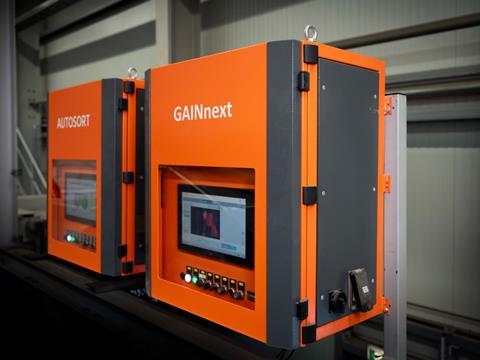
TOMRA seeks to separate food-grade PET, PP, and HDPE from their non-food-grade counterparts with a new sorting technology utilizing deep learning, as well as purify plastic and paper waste streams with deinking and cleaning machinery.
Deep learning is a subset of AI. TOMRA’s continued investment in GAIN, its deep learning-based sorting add-on for its AUTOSORT units, has allowed the company to develop a solution claiming to ‘quickly and efficiently’ separate food-grade and non-food-grade plastics on a large scale.
Now rebranded as GAINnext, the technology is reportedly capable of identifying objects that are difficult or even impossible to classify with optical waste sensors. TOMRA explains that these traditional solutions can struggle to separate food- and non-food packaging by sight alone, as they often look similar and/or are made of the same materials.
By bringing deep learning technology to conventional near-infrared, visual spectrometry, and other sensors, TOMRA claims to exceed purity levels of 95% for packaging plants and open up new revenue streams for its customers. It also intends to overcome the challenges posed by hygiene concerns and stringent industry regulations in the recycling processes for food packaging.
Two non-food applications have also been developed to complement the existing GAINnex system. One is designed to deink paper and purify paper waste streams, while the other is a PET cleaner application set to enhance the purity of PET bottle waste.
“We have used AI technology to improve sorting performance for decades, but this latest groundbreaking application marks another industry first for us,” says Dr. Volker Rehrmann, EVP, head of TOMRA Recycling. “AI has the power to transform resource recovery as we know it, and our latest sophisticated applications of deep learning and AI reinforce our position as a pioneer in this field.
“With its sophisticated use of deep learning, GAINnext enables food-grade sorting and bottle-to-bottle quality, tasks that have posed significant challenges for our industry for many years. The use of AI is driving material circularity at a time when it is needed most, with tightening regulations and increasing customer demand for technologically advanced solutions. At TOMRA, we’re proud to be driving the change in sorting.”
Indrajeed Prasad, product manager Deep Learning at TOMRA Recycling, adds: “The use of deep learning technology not only automates manual sorting but also enables the industry to achieve high-quality recyclates through more granular sorting. Thanks to its ability to detect thousands of objects by material and shape in milliseconds, GAINnext solves even the most complex sorting tasks.
“Plus, with its integrated deep learning software, it offers the opportunity to adapt to future demands.
“We are delighted to be able to launch these innovative and much-needed solutions to meet the ever more stringent quality requirements for sorting outputs, driven by the increasing demand from consumer brands for more high-purity recycled content.”
Over 100 AUTOSORT units with GAINnext technology are currently installed at material recovery facilities worldwide – including Berry Circular Polymers’ flagship facility in Leamington Spa, Viridor Avonmouth in Bristol, and the European Dentis Group’s French Nord Pal Plast plant.
Having visited TOMRA’s test centre, Professor Edward Kosior, founder and CEO of Nextek Ltd and its NEXTLOOPP initiative, commented: “TOMRA’s ground-breaking AI system, GAINnext, has propelled the recycling industry to an exciting pivotal juncture in plastic packaging sorting and creates new opportunities for closing the loop on many plastics in food-grade applications.
“GAINnext is poised to accelerate the most simplified, cost-effective and highly efficient sorting system on the market. We’re immensely proud to see our industry moving forward on this transformational journey.”
Other steps taken by TOMRA include its investment in PolyPerception, which develops AI-based waste flow monitoring for PET recyclers and sorting plants. TOMRA hopes that its contribution will improve its position in the AI space.
It has also partnered with Syensqo to prove the technical and economic viability of separating and sorting multi-component plastic structures with polyvinylidene chloride (PVDC) barrier layers.
In other news, Bollegraaf and Greyparrot have come to an agreement in which Bollegraaf with take a non-controlling stake in Greyparrot; Greyparrot will acquire Bollegraaf’s vision-based computing intellectual property and AI development team; and the companies will jointly work to retrofit recycling plants with artificial intelligence – diverting waste away from landfill, incinerators, and the natural environment.
If you liked this story, you might also enjoy:
Report: The ultimate guide to global plastic sustainability regulation
The Brief: Oxo-(bio)degradables: the who, what, and why of breaking down fossil-based plastics
Sustainable Packaging Summit: How Kraft-Heinz uses collaboration to drive innovation
The Brief: Using ocean-bound plastic in packaging – how, why and should we?












No comments yet